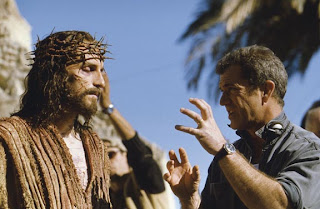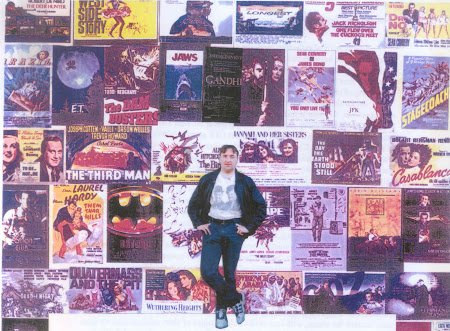
Then to my further surprise, it turns out that he is not actually Australian, but by birth a New Yorker, having moved to Australia when very young. On that basis his view about the English - in films such as Gallipoli, The Bounty, The Patriot and especially his Oscar-winning Braveheart - can be put into perspective.
And then the final, most surprising facet of Mel Gibson's personality, was to discover that he was a devout Roman Catholic, with his own special chapel high in the Hollywood hills that celebrates the traditional Tridentine Mass. From this multi-layered background, he made his most notorious and most profound film, The Passion of the Christ.
From my own point of view as a Roman Catholic, The Passion was not a new story. Born into a Catholic family in 1971, I was baptised on Easter Sunday at Westminster Cathedral (right), where along each column of the mighty main chapel, are the Twelve Stations of the Cross - as there are in most Catholic churches - telling the story of the crucifixion. They tell in effect the story of Jesus's suffering, that "Good" Friday, in sometimes harrowing but absorbing detail. I always find it moving to walk through a church and see each one of these twelve scenes, which are re-enacted in church every year on Good Friday.
In 1996 Colchester Theatre Group performed their own version of The Passion as written by English poet Tony Harrison (the second of a trilogy along with The Nativity and Domesday). This particular theatre version of the story was a semi-modernised production where the players were dressed as craftsmen and women, as the traditional players in a Passion play used to be.

In the production I played one of the four soldiers who arrest Jesus and eventually crucify him. As part of the semi-modernisation of the piece, for the crucifixion itself, instead of using a hammer and nail, we used an electric DIY drill to give the harrowing effect of Jesus being nailed to the cross.
I remember how the Essex County Standard reviewed this touch, saying that the use of a drill brought the 2000-year old story bang up to date, and also brought home the sheer brutality of a crucifixion. It was with this mental baggage in mind, that 8 years later I approached with great curiosity, Mel Gibson's The Passion of the Christ.
 Jesus died on the cross at the age of 33, which was also the age of actor Jim Caviezel when he took on the challenging role. Whilst a reasonably good actor with a handful of successful films under his belt, he was certainly no star; nor indeed was Maia Morgernstern as Mary, whom Gibson had spotted in a (forgettable) historical/sci-fi epic Nostradamus in 1995, and hunted high and low to find the woman who could be his Holy Mary, Mother of God. Indeed, nearly all the cast are relative unknowns, the only well known name (apart from the director) being Monica Belucci as Mary Magdalene, who commendably understates her role without ever diminishing her own attractiveness which fits in with that of her character.
Jesus died on the cross at the age of 33, which was also the age of actor Jim Caviezel when he took on the challenging role. Whilst a reasonably good actor with a handful of successful films under his belt, he was certainly no star; nor indeed was Maia Morgernstern as Mary, whom Gibson had spotted in a (forgettable) historical/sci-fi epic Nostradamus in 1995, and hunted high and low to find the woman who could be his Holy Mary, Mother of God. Indeed, nearly all the cast are relative unknowns, the only well known name (apart from the director) being Monica Belucci as Mary Magdalene, who commendably understates her role without ever diminishing her own attractiveness which fits in with that of her character.
The surprises continued. Gibson's first, most innovative move was to use old Latin and Aramaic as the principal languages with subtitles. This may have baffled some multiplex audiences unaccustomed to "foreign" films, but it's also worth noting that it increased the worldwide appeal of the film in countries outside of America.
The next, much more trumpeted surprise on the cards, was that this was to be not just another Biblical epic with a crucifixion scene.
I can remember when I saw the film at the Stratford Picture House in East London: the traditionally hardened East End audience started to laugh as the film opened - as most audiences nowadays would at this sort of "sword and sandals" entertainment. The laughing quickly stopped half way through.
The violence is uncomfortable, and most definitely not for the squeamish, but I found it powerful and cathartic. From my point of view Jesus's suffering on the cross was His way of taking on all the sins of the world, in order to redeem it. That means a lot of sin for him to have to take on.
So it follows that the punishment meted out to him is severe, barbarous, and in all truth, persistent enough to believe that the real Jesus Christ would not actually have survived such a butchering.
Much has been made of the anti-Semitic overtones (especially the controversial Biblical quote "let his blood be upon us" which was spoken but not translated), but little fuss was made about the greater amount of sadistic anti-Roman sentiment in the film (with the exception of a sympathetic portrayal of Pontius Pilate.) This has to be put into perspective: in a story such as this, there are protagonists and antagonists. The history speaks for itself, so the Romans and Jews are by necessity the antagonists. Who ever complains about the anti-German sentiments in so many war films? Or the anti-Red Indian element in so many Westerns?
And, as has often been used in defence, Jesus was himself a Jew. To criticise the story is really to criticise the New Testament, although to be fair, Gibson covered some of the scenes in much greater detail than the Bible ever did.
The occasional flashbacks to the Last Supper and other notable events in the New Testament were added as an afterthought. One of my favourites is a semi-comedic interlude where carpenter's son Jesus constructs a tall table for stools, which Mary chides "will never catch on!" This unexpected modern touch has the great knack of making Jesus a more accessible human figure, avoiding the easy trap of making Him overly pious. Another good flashback device is used in the moving scene where Peter denies Jesus three times, intercutting with his earlier vow to follow his Lord no matter what. As a result, you realise the anguish of Peter's denial.
There were those who felt that the film should have concentrated much more on these flashback scenes than the crucifixion, but again this is missing the point. "The Passion" is translated as meaning "suffering" and is all about Jesus's dying on the cross.
During another semi-flashback is perhaps the most powerful scene of the film for me. Mary is afraid to venture into the Mob that are tormenting her son on the procession up to Golgotha. Gibson brilliantly intercuts this with an image of the child Jesus falling over and hurting himself, to which the mother rushes over to comfort him, and likewise [and I'm weeping as I type this] she finds the courage to fight her way through the crowd and talk to her son, in a scene which embodies the power of maternal love, and the curiously powerful relationship between Mary and Jesus. And I credit Mel Gibson for having the skill (or perhaps the manipulation) to move me to tears.

I watched the film for the first time in the spring (near Easter time) of 2004, with the sound of the fine music (by John Debney) during the end titles rousing me, using a number of semi-spiritual musical sources (including Ennio Morricone's score for The Mission). The CD soundtrack is enjoyable enough in its own right to capture the flavour of the story.
In an age when so many films are being castigated for their perceived anti-Catholic sentiments, the hoo-ha about The Passion of the Christ seemed a little ironic, to say the least. I remember the tremendous fuss over Martin Scorsese's The Last Temptation of Christ, because of the use of a dream sequence in which Jesus steps down from the cross and marries Mary Magdalene. Again, this was taken out of context. Similarly, Monty Python's Life of Brian was taken to task by certain Christian organisations. It should also be noted however, that among many Roman Catholics it is considered a very funny film - and it's about Brian, NOT Jesus.
A double irony was that The Passion of the Christ, one of the most violent films ever made, was also one of the most successful (with foreign subtitles to boot), and also played in some American churches to full houses of the faithful.
I don't belittle the passions of the devout who adore this film as Deliverance, nor those who cannot stand the film's provocative stance and violence. It is an experience as well as a film, and one that I would not repeat often. But in so many other ways it is a powerful memory.

Here was a film which had a doubly profound impact on me, as one who had not openly embraced the Roman Catholic Church for some time, but had more recently become a devotee of the cinema. The two came together in perfect unity, a symbiosis of film and the faith, that assimilated many of my feelings about the subject.
I've never known a film to polarize opinion quite so much as this one. There is almost no middle ground: you either love it or hate it. For those who can take the violence and the sadism, and are prepared to treat it with an open mind, I would strongly recommend it.
The Passion of the Christ was something of a prodigal film, and also one of the most remarkable achievements of cinema in recent days. A controversial classic.

